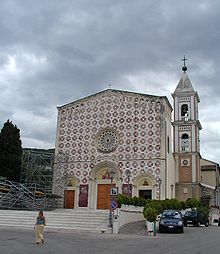Manoppello Image
The pilgrim gave the package to Dr. Giacomo Antonio Leonelli, who was sitting on a bench in front of the church.
In 1608, Pancrazio Petrucci, a soldier married to Marzia, a member of the Leonelli family, stole the veil from his father-in-law's house.
A few years later, Marzia sold it for 400 scudi to Doctor Donato Antonio De Fabritiis to pay a ransom demand for her husband who was a prisoner in Chieti.
This history has been documented by Father Donato da Bomba in his Relatione historica and is based on research that had been started in 1640.
[citation needed] In 1999, German Jesuit Heinnrich Pfeiffer, Professor of Art History at the Pontifical Gregorian University,[1] announced at a press conference in Rome his discovery of the veil in the church of the Capuchin monastery, where it had been since 1660.
Nevertheless, the cloth has received much publicity in recent years and Pope Benedict XVI visited the veil on 1 September 2006.
[12][full citation needed][13] A further objection, advanced by Ian Wilson, is that because the image does not bear a familial resemblance to known copies (see above), it cannot be the version of the Veronica that was venerated in the Middle Ages.
Gian Marco Rinaldi from the Italian Committee for the Investigation of Claims of the Paranormal (CICAP) goes as far as to say that the theory according to which there would not be any trace of pigment on the Manoppello Image is nothing but an "urban legend", which takes its roots from internet sites and blogs as well as from the public statements of religious authorities in Italy and many articles from Paul Badde in Die Welt, all of whom have extrapolated dubiously the works of Donato Vittore and Giulio Fanti.
Rinaldi insists upon the fact that Fanti and his associates never said in any paper whatsoever that the Manoppello Image corresponded "exactly" to the Turin Shroud, and that such an extrapolated statement has only been made public by sister Blandine Schlömer, a Trappist nun from Manopello in charge of communicating with the media.


